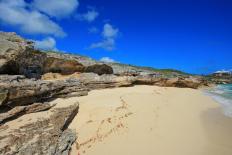Geomorphological peculiarities of AEOLianite KARST and their palaeoclimatic significance
Principal Investigator at ZRC SAZU
Matej Lipar, PhD-
Original Title
Geomorfološke posebnosti krasa na eolskih kalkarenitih in njihova pomembnost za preučevanje paleoklime
Project Team
Mateja Ferk, PhD, Matej Lipar, PhD-
Project ID
N1-0162
-
Duration
1 September 2020–31 August 2022 -
SICRIS
SICRIS -
Lead Partner
-
Project Leader
Matej Lipar, Ph.D.
-
Financial Source
ARIS - Slovenian Research And Innovation Agency

Over the past million years, Earth’s climate has oscillated between glacial and interglacial periods, marked by either colder or warmer temperatures. The present interglacial period will inevitably transition into a new glacial period. This change will be superimposed on the current trend of global warming; how these two opposite trends will interact is unclear. Climatic changes influence the landscape, and knowing the landscape response helps humanity to find solutions to adapt to or prevent the environmental changes. In terms to provide new robust interpretations of palaeoclimate development and subsequent landscape response, it is necessary to gain direct insights into each glacial/interglacial and the transitional period.
Aeolianites (cemented carbonate dunes) are a valuable tool to improve our understanding of climate-landscape interactions. This is because the combination of aeolianites’ stratigraphic sequence and post-depositional landscape modification (cementation, dissolution, karst formation) in Quaternary provide a reliable, undisturbed and interconnected timeline of past environmental changes and mirror the direct landscape response during interglacial-glacial climatic cycles.
The aim of the project is to strengthen the role of aeolianites in combination with karst geomorphology as a reliable palaeoenvironmental archives by elucidating current scientific gaps. This includes (1) defining of the large overall distribution and timing of aeolianite deposition in the Mediterranean setting with perspective of present environment that is not favourable of large dune deposition in general; (2) constraining the time-growth of one of the most apparent karst features in aeolianites – solution pipes; and (3) comparing karst development in aeolianites of different percentage of insoluble grains.
The research will fill an important gap in understanding how aeolianites indicate landscape response to major climate changes across different timescales.
Completed project steps:
- The synthesis of available data to construct the database and map of all areas with aeolianite deposition in the Mediterranean.
- Regional linking to establish the reliable pattern of environmental change, sensitive to initial conditions and at the same time uniformitarian for the Mediterranean.
- Field work, followed by sample collection of solution pipes’ rim and on field morphometric measurements.
- Determination of cement fabrics of solution pipe rim by examination of geological thin sections coupled with XRD for mineralogy.
- High-resolution uranium/thorium (U-Th) dating of cement layers of solution pipes. A novel approach to use U/Th dating technique will provide a first direct dating of karstification process.
- The synthesis of available data of the percentage of insoluble grains within the aeolianites and characteristics of karst development.
- Improve the synthesis data by additional analyses from regions where the data is not available; this includes field-work, thin section analysis, grain size analysis and mineralogy (XRD).
- Interpretation, synthesis and integration of all the data obtained in order to strengthen the role of aeolianites in combination with karst geomorphology as a reliable palaeoenvironmental archives.
Scientific papers:
- 2022 – Earth Surface Processes and Landforms - Enigmatic annular landform on a Miocene planar karst surface, Nullarbor Plain, Australia
- 2022 – Data - Bihourly subterranean temperature and relative humidity data from the Nullarbor Plain, Australia (Nov 2019–Mar 2021)
- 2021 – Geomorphology - Sinkhole development in the Sivas gypsum karst, Turkey
- 2021 – Earth-Science Reviews – Solution pipes and focused vertical water flow: Geomorphology and modelling
Other publication:
- 2022 – The Conversation - A giant ‘bullseye’ on the Nullarbor Plain was created by ancient sea life
- 2022 – Envirotalk Newsletter - Solution pipes in Bermuda
Conferences:
- 2022 – ANZGG (Australian and New Zeland Geomorphology Group) Biennal Conference - Enigmatic annular landform on the Nullarbor Plain, Australia
- 2022 – ANZGG (Australian and New Zeland Geomorphology Group) Biennal Conference - Denuded caves on the Nullarbor Plain, Australia
- 2022 – IAG (International conference on geomorphology) – Quaternary coastal dune limestone karst
- 2022 – ICS (International Congress of Speleology) scientific conference - Fluviokarst on quaternary eogenetic conglomerates : an example from Slovenia
- 2022 - EGU (European Geosciences Union General Assembly) - Challenges in characterisation and mapping of solution pipes
- 2021 – MedGU (Mediterranean geosciences Union Annual Meeting) – Syngenetic karst, a global overview
- 2021 – EGU (European Geosciences Union General Assembly) – Impact crater versus bioherm on the Nullarbor Plain, Australia
- 2021 – IKS (International Karstological School) – Imaging solution pipes : case study from Miocene calcarenites in Poland
